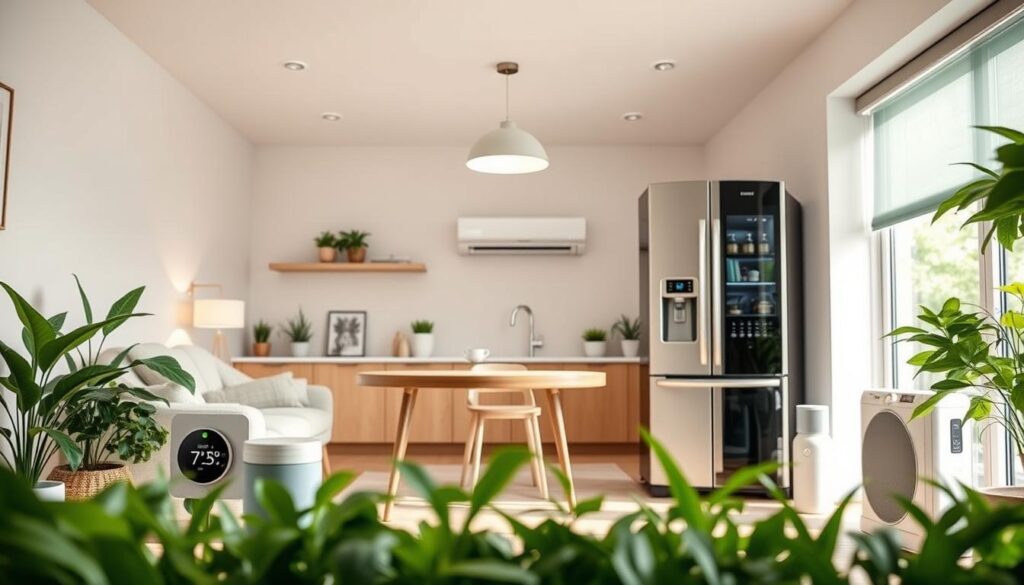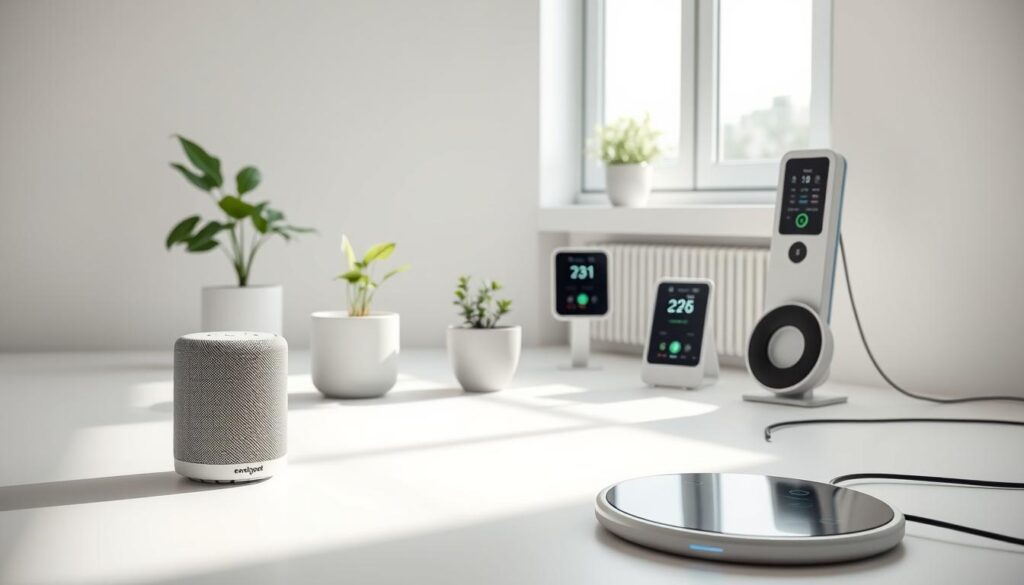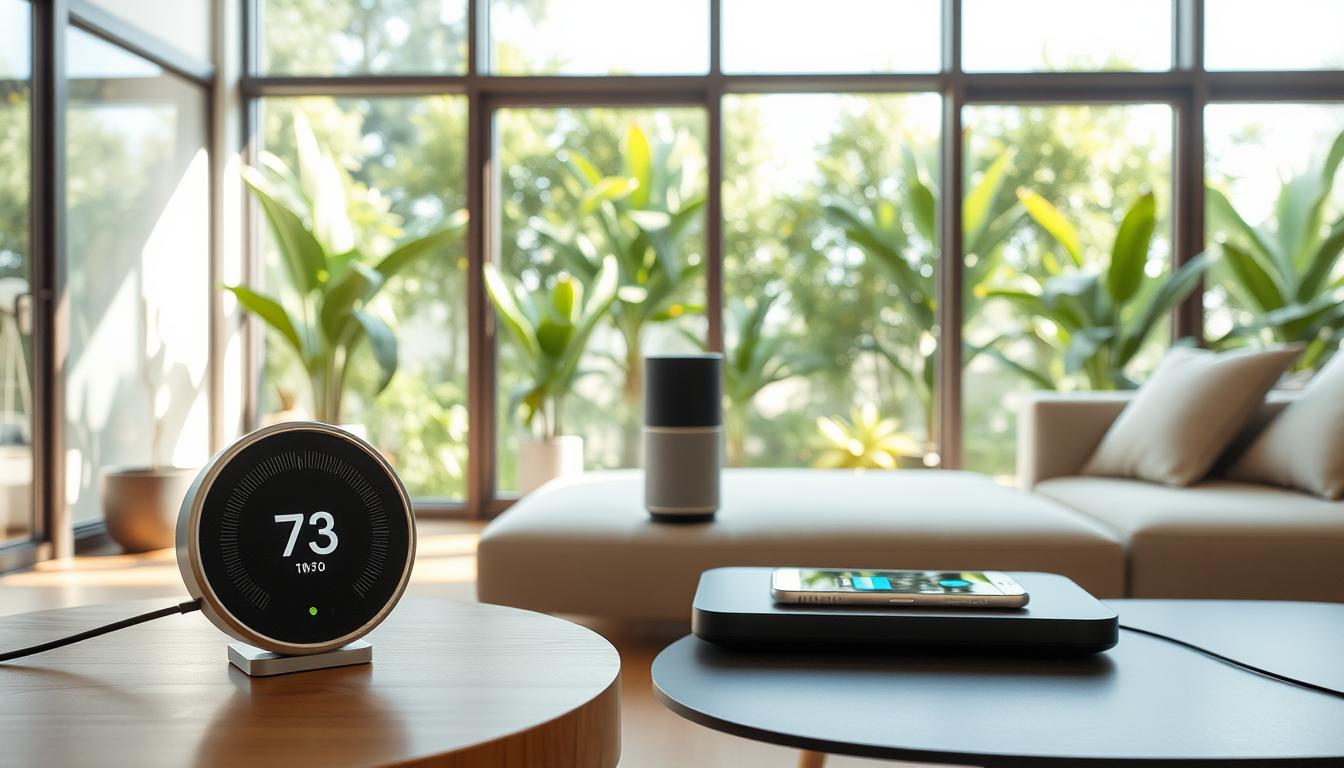Welcome to a new era of home living where eco-friendly gadgets for home are reshaping daily life. Imagine smart devices that conserve energy, reduce waste, and make sustainability effortless. Innovations like Nest Learning Thermostats and Philips Hue LED lights show how tech can align with environmental goals, making eco-conscious choices practical and convenient.
From solar-powered gadgets to energy-efficient appliances, these tools are more than trends—they’re solutions for a greener future. In 2025, eco-friendly gadgets for home promise to balance modern comfort with planetary responsibility, offering households a path to smarter, sustainable living.
Key Takeaways
- Eco-friendly gadgets for home merge cutting-edge technology with eco-conscious design.
- Devices like smart thermostats and solar-powered appliances cut energy use and costs.
- 2025 trends highlight gadgets that simplify sustainable living without sacrificing convenience.
- These innovations help reduce carbon footprints while enhancing home efficiency.
- Eco-friendly gadgets for home are vital for both environmental and financial long-term benefits.
Embracing the Future of Sustainable Living
From solar-powered lights to smart thermostats, sustainable home technology is reshaping how we live. Innovations like Tesla’s solar roofs and Philips’ LED lighting systems prove eco-conscious choices can blend seamlessly with modern living. These gadgets aren’t just trends—they’re solutions.
The Rise of Eco-Friendly Gadgets
- Solar panels now cost 82% less than in 2010, making them accessible for average households.
- Smart sensors automatically adjust energy use, reducing waste without sacrificing comfort.
- Companies like Ecobee offer thermostats that learn routines, cutting heating/cooling costs by up to 23%.
Benefits of a Greener Lifestyle
Adopting these technologies creates ripple effects:
- Cuts monthly utility bills by 15-30%.
- Reduces carbon footprints by integrating with apps like Google Home for real-time energy tracking.
“Sustainable home tech isn’t optional—it’s the next step in responsible innovation.” — 2024 Green Tech Report
These tools empower homeowners to protect the planet while enjoying smarter living spaces. The shift isn’t just ecological; it’s a smart investment in cleaner energy and long-term savings.
Transforming Spaces with Eco-friendly gadgets for home
Green living devices are redefining how we design and experience living spaces. From lighting to climate control, these innovations merge style with sustainability. Imagine a kitchen where smart compost bins track waste, or a living room where solar-powered speakers play music while cutting energy use. These tools don’t just function—they transform rooms into hubs of eco-conscious design.
- Smart Lighting: Philips Hue bulbs adjust brightness and color to match moods while using 80% less energy than traditional options.
- Climate Control: Nest thermostats learn your habits, saving energy without sacrificing comfort.
- Outdoor Tech: Solar-powered patio heaters from brands like EcoFlow blend with modern backyards, reducing grid dependency.
Designers now prioritize materials like recycled plastics and bamboo in devices, making sustainability visible. A modular shelving system from IKEA, for example, uses reclaimed wood to double as art and storage. Even small items like Wi-Fi enabled plant sensors (e.g., Parrot Flower Power) remind us to care for greenery, turning corners of homes into thriving ecosystems.
These gadgets prove eco-friendly tech doesn’t mean sacrificing style. They’re bridges between aesthetics and ethics, making sustainable living both practical and appealing. Whether it’s a sleek air purifier from Dyson or a voice-controlled window opener, every choice reshapes spaces into spaces that nurture both people and the planet.
Sustainable Home Technology Trends for 2025
From solar-powered refrigerators to AI-driven energy monitors, environmentally friendly household appliances are shaping the future of home tech. Innovations prioritize efficiency without sacrificing convenience.
Latest Tech Innovations
- Samsung’s Solar-Powered Air Conditioners: Cut grid reliance by 60%.
- Whirlpool’s Smart Recycling Washers: Use 40% less water per cycle.
- Ecobee Smart Thermostats: Automatically adjust heating/cooling to reduce emissions.
| Technology | Energy Savings | Adoption Rate (2023) |
|---|---|---|
| Solar-integrated appliances | 35% | 12% U.S. households |
| AI energy management | 28% | 18% U.S. households |
Market Forecasts and Opportunities
Analysts predict the environmentally friendly household appliances market will hit $250B by 2025, growing at 8.2% annually. Key drivers include:
- Rising consumer demand for carbon-neutral living.
- Government incentives like the U.S. Inflation Reduction Act subsidies.
- Corporate sustainability commitments driving product development.
“2025 will be a turning point for mass adoption of eco-tech in homes.” — Grand View Research Report, 2023
Green Living Devices: A New Era for Households
Households worldwide are embracing energy-efficient smart home devices to simplify sustainability. These innovations blend tech and ecology, making eco-friendly living effortless. Imagine lights that dim when sunlight fills a room or thermostats that adjust temperatures based on your habits. Brands like Philips and Nest lead this shift, offering systems that slash energy waste while keeping homes comfortable.

Adopting Eco-Conscious Solutions
Adopting these devices starts with small changes. Smart plugs track appliance usage, while sensors turn off lights in unused rooms. For example, Ecobee’s thermostats save up to 20% on heating costs by learning routines. Here’s how they help:
- Real-time energy reports show savings instantly.
- Automation reduces manual adjustments, making efficiency hands-free.
- Long-term use lowers carbon footprints and utility bills.
These tools are more than gadgets—they’re pathways to a greener future. Homeowners in the U.S. are adopting them to balance modern convenience with environmental responsibility. From smart bulbs to smart gardens, the choice to go green is now a click away.
Energy-Efficient Smart Home Devices Revolution
Smart home tech is no longer just about convenience—it’s about sustainability. Energy-efficient devices now lead the charge in reducing household carbon footprints. Eco-conscious home gadgets like Wi-Fi enabled thermostats and motion-sensor lighting cut energy use without sacrificing comfort.
- Smart thermostats (e.g., Nest Learning Thermostat) learn routines to save 10-15% on heating/cooling bills.
- Solar-powered chargers (e.g., EcoFlow Delta Max) harness renewable energy for off-grid power.
- Smart plugs automatically turn off idle devices, slashing standby power waste by up to 30%.
| Device | Traditional Cost/year | Eco Option Cost/year | Savings |
|---|---|---|---|
| Lighting | $120 | $45 | 62.5% ↓ |
| Heating | $400 | $280 | 30% ↓ |
| Water heaters | $200 | $130 | 35% ↓ |
“Smart sensors and AI integration are making energy efficiency effortless for everyday users.” — Dr. Linda Carter, Clean Tech Analyst
These innovations don’t just save money—they reduce reliance on fossil fuels. Brands like Philips and August are embedding sustainability into design, proving eco-conscious home gadgets can enhance lifestyles affordably. From voice-controlled energy monitors to solar-integrated security systems, this revolution turns every room into a hub of efficiency.
Environmentally Friendly Household Appliances in Today’s Market
Today’s market offers green technology products for the home that blend top-tier performance with planet-positive choices. From smart thermostats to energy-efficient refrigerators, these appliances prove eco-friendly doesn’t mean compromise. Top brands like LG and Whirlpool now prioritize sustainability without sacrificing functionality.
“The best eco-friendly appliances deliver measurable savings while reducing environmental footprints,” states Emily Carter, a home tech analyst at GreenTech Insights.
Performance and Savings
Leading models like the LG ThinQ Smart Air Conditioner use AI to cut energy use by up to 30%. Similarly, Haier’s solar-powered water heaters slash utility bills by 25% yearly. Savings vary, but most users see returns in 2–3 years.
- Smart thermostats save $180/year on heating/cooling
- Energy Star-certified dishwashers use 50% less water
- LED lighting systems last 25 times longer than traditional bulbs
Measuring Environmental Impact
Track results with tools like the EPA’s Energy Star calculator or apps like EcoCycle. Look for certifications like Energy Star or Cradle to Cradle to confirm durability and recyclability. Check manufacturer reports on lifecycle emissions and energy efficiency ratings.
Invest in appliances with clear sustainability metrics. Brands like Bosch provide carbon footprint data online, making it easy to compare options.
Smart Home Integration: Blending Sustainability with Innovation
Modern smart home systems now merge eco-conscious design with cutting-edge tech. Eco-friendly home innovations like automated climate controls and solar-integrated devices let users manage resources efficiently. These systems work together to reduce waste while keeping homes comfortable.
Seamless Connectivity
Devices like smart thermostats, energy monitors, and LED lighting systems connect via apps or voice commands. This network ensures all gadgets work together to save energy.
- Smart Thermostats: Nest Learning Thermostat adjusts heat based on occupancy.
- Solar Panels: Tesla Powerwall stores excess energy for later use.
- Lighting: Philips Hue bulbs dim automatically when natural light is available.
| Device Type | Eco-Benefit | Brand Example |
|---|---|---|
| Smart Thermostats | Reduces heating/cooling waste by 10-30% | Nest |
| Solar Storage | Cuts grid dependency by 40% | Tesla Powerwall |
| Smart Lighting | Cuts electricity use by 50% via motion sensors | Philips Hue |
User Experience and Efficiency
Users control all devices through one app, track energy use in real time, and set custom schedules. This hands-off efficiency makes sustainability effortless.
“Smart integration isn’t just tech—it’s about making green choices automatic.” – GreenTech Insights, 2024
Eco-Conscious Home Gadgets: Style Meets Functionality
Eco-conscious home gadgets today combine sleek designs with green tech. They prove that sustainability doesn’t mean sacrificing style. From lighting to kitchen tools, sustainable living gadgets now offer modern aesthetics while reducing environmental impact.
- Philips Hue LED bulbs blend energy efficiency with customizable lighting, fitting seamlessly into contemporary homes.
- EcoSmart’s solar-powered chargers pair minimalist design with off-grid functionality.
- Bluesmart suitcases feature solar panels and sleek lines, merging travel tech with eco-values.
“Sustainable design is the new luxury,” says Design Trends 2025, noting 68% of buyers prioritize style and eco-friendliness equally.

These gadgets prove that eco-conscious choices can elevate home decor. Brands like IKEA and Nest now offer smart thermostats and furniture made from recycled materials that look as good as they perform. Sleek solar-powered speakers from brands like Rothy’s blend tech with earth-friendly materials, proving sustainability and aesthetics go hand-in-hand. As trends shift, stylish sustainable living gadgets become must-haves for eco-conscious households.
Green Technology Products Enhancing Daily Living
Modern eco-friendly gadgets aren’t just tools—they’re stylish upgrades that simplify life while saving resources. From lighting to climate control, smart designs now prioritize both style and sustainability.
“Innovation meets nature: The best tech feels invisible until you see the energy savings.”
- Philips Hue Lightstrip: Adjustable LED strips use 80% less energy than traditional bulbs, offering customizable ambiance.
- LG Eco Hybrid Heat Pump: Cuts heating costs by 30% while blending into modern kitchen designs.
- Nest Learning Thermostat: Learns routines to reduce energy waste by up to 10-12% annually.
| Product | Energy Savings | Design Features |
|---|---|---|
| Philips Hue | 80% reduction | Modular, dimmable |
| LG Eco Hybrid | 30% cost savings | Compact, stainless steel |
| Nest Thermostat | 10-12% annual savings | Minimalist, touchscreen |
These examples show how green tech now fits seamlessly into everyday routines. Whether upgrading lighting, heating, or climate control, these products prove sustainability doesn’t mean sacrificing aesthetics or convenience.
Sustainable Living Gadgets for a Brighter Future
Making the switch to eco-friendly tech isn’t just good for the planet—it’s smart for your wallet too. Let’s break down how these gadgets pay off in real life.
Cost Savings and Return on Investment
Smart choices like solar-powered lights or energy-efficient refrigerators cut electricity bills fast. Take the Ecobee Smart Thermostat: it learns your habits, saving up to 23% on heating costs annually. Over time, these savings add up, turning small investments into long-term wins.
- LED lighting: Lasts 25x longer than old bulbs, slashing replacement costs.
- Water-saving showerheads: Reduce usage by 30% without sacrificing pressure.
- Smart power strips: Automatically shut off unused devices, saving $100+ yearly.
Long-Term Benefits of Green Living
These gadgets do more than save money. Solar panels reduce carbon emissions equal to planting 100 trees yearly. Plus, homes with energy-efficient appliances see higher resale value—up to 9% more, according to the U.S. Department of Energy.
“Every small step toward sustainability creates a ripple effect,” says the EPA’s 2024 Climate Report. “Households are the backbone of global progress.”
Investing in tech like LG’s ThinQ Smart Appliances or Philips Hue Lightstrip means cleaner air, quieter homes, and a healthier planet. The future isn’t just eco-friendly—it’s affordable and rewarding.
Conclusion
Eco-friendly gadgets are reshaping homes into centers of sustainability. Innovations like energy-efficient smart home devices and solar-powered appliances make eco-conscious living achievable. Brands such as Philips and Samsung offer tech that cuts energy use while boosting comfort. These sustainable home technologies aren’t just trends—they’re tools for lasting change. By adopting energy-efficient options today, households reduce costs and environmental impact. As 2025’s advancements grow, choosing green living appliances becomes easier, from smart thermostats to eco-friendly lighting. Every upgrade, from a solar panel to a water-saving fixture, contributes to a cleaner planet. The future of smart homes depends on blending sustainability with style. Making these choices now ensures homes stay ahead of trends while protecting resources. Sustainable innovations prove that tech can drive progress without harming the earth. The path to a greener tomorrow starts with the choices made in every home today.
FAQ
What are some popular eco-friendly gadgets for home use?
Some popular eco-friendly gadgets include smart thermostats like the Nest Learning Thermostat, energy-efficient appliances from brands like Bosch, solar-powered chargers, and LED lighting systems. These not only help in reducing energy consumption but also support a sustainable lifestyle.
How can sustainable home technology save me money?
Sustainable home technology, such as energy-efficient smart home devices, can save you money by reducing your utility bills. Devices like smart thermostats can optimize energy usage, while LED lighting systems consume less power, leading to long-term savings.
What are the benefits of using green living devices?
Green living devices offer numerous benefits, including lower energy costs, decreased environmental impact, improved air quality, and enhanced comfort in your home. These eco-conscious solutions often integrate seamlessly into your daily life while supporting a sustainable lifestyle.
How do I know if an appliance is environmentally friendly?
Look for certifications such as ENERGY STAR, which indicate that the appliance meets energy efficiency guidelines set by the U.S. Environmental Protection Agency. Research product reviews and specifications to ensure that the device not only performs well but also minimizes its environmental impact.
What are some trends in sustainable living gadgets for the upcoming years?
Upcoming trends in sustainable living gadgets include increased reliance on smart technology, enhanced features for energy monitoring, and a focus on recyclable materials in manufacturing. Innovations such as solar-powered appliances and smart home integration systems are also gaining traction.
Can I integrate sustainable technology into my existing home?
Absolutely! Many eco-friendly gadgets are designed for easy integration into existing homes. For example, smart thermostats, energy-efficient LED bulbs, and water-saving fixtures can be installed without major renovations, making it easier to adopt a greener lifestyle.
Are there eco-friendly options for home security systems?
Yes! Many modern home security systems offer eco-friendly features, such as solar-powered cameras and devices with energy-saving modes. Brands like Ring and Arlo provide security solutions that are both effective and designed with sustainability in mind.
What impact do eco-friendly home innovations have on the environment?
Eco-friendly home innovations directly contribute to reducing carbon footprints by conserving energy and resources. By using energy-efficient appliances and sustainable technologies, homeowners can significantly lower greenhouse gas emissions and promote a healthier planet.
